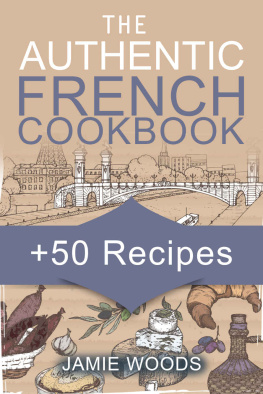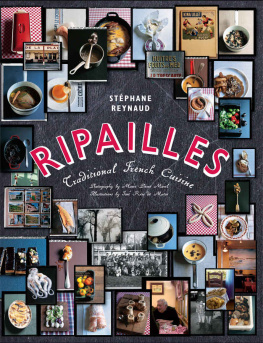Murdoch Books Test Kitchen - The Little French Cookbook
Here you can read online Murdoch Books Test Kitchen - The Little French Cookbook full text of the book (entire story) in english for free. Download pdf and epub, get meaning, cover and reviews about this ebook. year: 2016, publisher: Murdoch Books, genre: Home and family. Description of the work, (preface) as well as reviews are available. Best literature library LitArk.com created for fans of good reading and offers a wide selection of genres:
Romance novel
Science fiction
Adventure
Detective
Science
History
Home and family
Prose
Art
Politics
Computer
Non-fiction
Religion
Business
Children
Humor
Choose a favorite category and find really read worthwhile books. Enjoy immersion in the world of imagination, feel the emotions of the characters or learn something new for yourself, make an fascinating discovery.
- Book:The Little French Cookbook
- Author:
- Publisher:Murdoch Books
- Genre:
- Year:2016
- Rating:5 / 5
- Favourites:Add to favourites
- Your mark:
- 100
- 1
- 2
- 3
- 4
- 5
The Little French Cookbook: summary, description and annotation
We offer to read an annotation, description, summary or preface (depends on what the author of the book "The Little French Cookbook" wrote himself). If you haven't found the necessary information about the book — write in the comments, we will try to find it.
Murdoch Books Test Kitchen: author's other books
Who wrote The Little French Cookbook? Find out the surname, the name of the author of the book and a list of all author's works by series.
The Little French Cookbook — read online for free the complete book (whole text) full work
Below is the text of the book, divided by pages. System saving the place of the last page read, allows you to conveniently read the book "The Little French Cookbook" online for free, without having to search again every time where you left off. Put a bookmark, and you can go to the page where you finished reading at any time.
Font size:
Interval:
Bookmark:


The Little French Cookbook features over 80 recipes
that reflect the delights of Frances culinary landscape:
delicate hors doeuvres, diverse seafood offerings,
hearty meat and poultry dishes, and delicate pastries
and desserts. These are recipes that capture the essence,
variety and rich heritage of regional French cooking
at its best.





C ONTENTS


T he F rench preside over one of the worlds great culinary heritages and nowhere is that heritage more celebrated, or enjoyed, than in F rance itself.

Frances reputation for wonderful food and cooking is often thought of as being based on technical skills and extravagant, expensive ingredients on sauces that need to be reduced, and foie gras, truffles and other delicacies. This is haute cuisine, classic cooking, which was developed by the chefs of the French aristocracy and reached its heyday in the nineteenth century under legendary French chefs such as Auguste Escoffier.
H aute cuisine is a time-consuming art form that adheres to strict rules. This elegant form of cooking requires an understanding of its special methods and techniques, skills honed by long apprenticeships in the kitchens of the great restaurants, particularly in creating the subtle sauces that are its foundation. Nowadays this style of cooking is found mostly in expensive restaurants, but it can represent the highest art of cooking, one celebrated in stars by the famous Michelin guide.
Nouvelle cuisine, new cooking, was a reaction to the dominance of haute cuisine in the 1960s, when chefs, including Paul Bocuse and the Troisgros brothers, banded together to create lighter dishes, with less reliance on heavy sauces and a willingness to experiment with non-traditional ingredients and cooking styles. Nouvelle cuisine has encouraged innovation, and though some of its precepts were later abandoned, it had a lasting influence on French cooking.
Fundamentally, however, French food is a regionally based cuisine and many French dishes are named after their place of origin, from sole la normande, to boeuf bourguignon. Eating your way around France the regional differences are still very distinct, and most restaurants cook not only the local dishes, but those of their own town or village. This is a result not only of tradition, but also of an enduring respect for local produce, the produits du terroir. Each area of France grows or produces food uniquely suited to its terrain and climate, from Bresse chickens to walnuts from Grenoble, butter from Normandy and mustard from Dijon. Today, there is more crossover between the provinces, and in markets, the best, not just the local, can be found, but the notion of regional specialities still underlies French cooking.
This respect for ingredients extends to only eating fruit and vegetables at the height of their season. Recipes change to reflect the best that each month has to offer, and every month, seasonal fruits and vegetables are eagerly awaited, from the summer melons of Provence to autumn walnuts and winter truffles in the Dordogne.
The French have gone to great lengths to protect their ingredients and traditional methods of food preparation. The Appellation dOrigine Contrle (AOC) system that they use to keep their cheeses and wines authentic is also being extended to an increasing number of important and regionally based food products, from Puy lentils to carrots from Crances.

The French love food and though many traditions have changed, and an office worker is just as likely to grab a sandwich on the run as enjoy a four-course lunch, as a foundation of French culture, eating and drinking remain incredibly important. One of the great joys of France is starting the morning with a petit djeuner of a fresh croissant and a caf au lait. Lunch is still for many the main meal of the day, though dinner may be equally substantial, and with many shops and work places closed between 12:30 and 3:30, it can sometimes extend to three or four courses with wine.
Despite the emergence of the hypermarch, specialist food shops and weekly markets are an integral part of the French way of life. There is a boulangerie in every village; meat is purchased at a boucherie; while a charcuterie specialises in pork products and delicatessen items and a ptisserie in baked goods. Markets are usually held weekly, and in some areas you can follow the same stallholders from town to town through the week. Even Paris has its neighbourhood markets, and there are also speciality markets, such as the garlic market in Aix-en-Provence in July and the foie gras market in the winter in Sarlat in Prigord.
THE FOOD OF THE NORTH
Paris is a world culinary centre, where local markets sell fantastic produce from all over France. Much of the citys reputation lies with its restaurants, a legacy of the revolution when private chefs had to find a new living. Parisians are discerning about their food and it is here you find the real home of the baguette, the countrys most refined ptisserie and finest cheese shops.
Brittany is traditionally a fishing and farming region with outstanding seafood, including native oysters, and wonderful early fruits and vegetables. Sweet crpes and savoury buckwheat galettes are found throughout the region. Its sea salt, sel de Gurande, is used all over France.
Normandy is home to some of Frances greatest cheeses: Camembert, Pont lEvque and Livarot; along with crme frache, butter and apples three of the classic ingredients in French cuisine. There is also pr-sal lamb (lamb raised in salt marshes), mussels, oysters, cider and calvados.

Known as the Garden of France, the Loire Valley produces fruit, vegetables and white wines. Wild mushrooms are grown in the caves of Saumur and regional dishes include rillettes, andouillettes and tarte Tatin. The region also produces fine goats cheeses, including Crottin de Chavignol. Poitou-Charentes on the Atlantic Coast has some of Frances best oyster beds near Marennes, and is also home to Charentais melons, unsalted butter and Cognac.
Font size:
Interval:
Bookmark:
Similar books «The Little French Cookbook»
Look at similar books to The Little French Cookbook. We have selected literature similar in name and meaning in the hope of providing readers with more options to find new, interesting, not yet read works.
Discussion, reviews of the book The Little French Cookbook and just readers' own opinions. Leave your comments, write what you think about the work, its meaning or the main characters. Specify what exactly you liked and what you didn't like, and why you think so.










